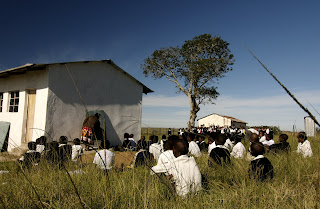First, let us
apologize for the delay in posting. As you can imagine, it is difficult to find a reliable and accessible
Internet connection. There may be a few days at a time without a post, then 3 in a day. Be assured that we are writing
every night and you will be kept as up to date as fast as we can post.
We finally made it to Coffee Bay. After spending the night in Durban, we woke a bit jet lagged and confused, because with travel and time-zones, we had completely missed Thursday. We experienced our first example of
Ubuntu last night. A man we met on the plane was flying back from Mozambique. He is helping to organize a pan-African arts program and happened to be sitting next to us on the flight (check out his program here
http://www.cca.ukzn.ac.za/). After sharing stories about our respective projects, Peter and his wife Monica
recommended an inexpensive place to stay for the night at the historic Durban Club (a fine place, but our shower didn't work) and offered us a ride to the hotel. Thank you both for your warmth, generosity and supportive words.
The ride from Durban was a ride through the diversity of South Africa itself. The further you travel outside the major cities, the more you see what makes South Africa unique. Beautiful landscaped dotted with mud huts (called
Rodewels), clay shacks covered by corrugated metal roofs and other assorted dwellings. Every few dozen kilometers, we came
across a semi-urban center busy with road side
vendors and food stands highlighting a maze of people jumping in and out of traffic trying to sell their wares.
One fact about this region that is hard to ignore is the lack of transportation. Along every road, especially major highways are Africans walking to and from the market or work (wherever that happens to be that day). Despite what has been called the best economy in Africa, the unemployment rate can at any given time reach as high as 40%. This sad trend is most visible in the Eastern Cape as you pass by a middle-aged woman carrying a hundred pounds or more of lumber precariously balanced on her head, or a group of men holding up a finger to passing
vehicles (a gesture that means "one man, one job, one day"). They are day laborers looking for work to feed their family, often large and covering three generations.
Once we pass
Mthatha (
Umtata), we soon reach the "Wild Coast", a stunningly beautiful region known for its rich cultural history,a region giving birth to many leaders of the country (Nelson Mandela and Oliver
Tambo to name a few) and unfortunately its unacceptable level of poverty. Things that might at first seem quaint, like cattle crossing the road or children playing barefoot in a dried-up riverbed are just
prevalent signs of neglect that this area has suffered through. Houses are left to erode without repair, school building stand empty and far away from those that could fill it with books and desks, and hours are spent everyday merely getting potable water from place to place.
We are left with a mix of overwhelming emotions that are hard to define.
We reach our destination of Coffee Bay about 36 hours after leaving NYC with tired bodies but an energized resolve to make this project
successful. Our work begins tomorrow as we travel around
Coffee Bay and get to know the people a little better.






